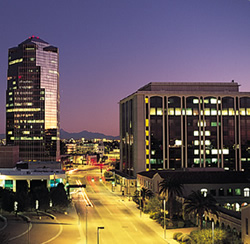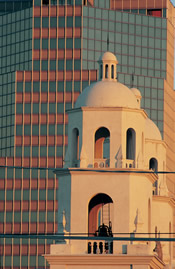 |
|
Photo
courtesy of Metropolitan Tucson CVB |
Tucson, AZ Review
No
matter how hot, cold, rainy or otherwise dismal
it is in any other part of the country, most
look to that unseemly deep-red spot in the lower
left-hand corner of the USA Today weather map,
see the coordinating triple-digit temperatures,
cringe and thank their lucky stars that "at
least we're not there."
'There'
is here - Tucson, Arizona, and such was my
grave concern as I pondered a move from the
opposite extreme, Chicago. But with one full
summer under my belt and another in progress,
I'm here to report that, 'dry heat' clichés
aside - it's really not so bad. In fact, summertime
in the Sonoran Desert can be seductive, dramatic
and surprisingly manageable.
The
key to survival, learned from the nocturnal
rhythms of the desert wildlife, is simple
- stay out of the sun during the peak heat
hours and make the most of the early morning
and sultry hours after sunset, when the air
is at once thick with the sweet aroma of the
desert, but light and refreshing.
Visit
one of the city's favorite hiking spots, Sabino
Canyon, at 5 or 6 a.m., for instance, and
you'll be among a steady stream of hikers,
bikers, runners and walkers taking to the
trails to seize the day before it can seize
them. Come to the park later in the afternoon
and you'll find the place nearly deserted.
Want
to try to beat those annoying yard sale early-birds?
Better set that alarm early - most who hold
yard sales this time of year set up at the
crack of dawn and are finished by noon, at
the latest.
 |
|
Photo
by Richard Cummins, courtesy Metropolitan
Tucson CVB |
As
afternoon sets in, neighborhoods become still
and eerily quiet. The lively chatter of morning
birds disappears and is replaced by the monotone
buzzing of air-conditioners, casting a mesmerizing
white noise over the city. Even the wind seems
fatigued by the heat. Languid mesquite trees
sway in slow motion to its hot breezes. Only
the gecko lizards appear unfazed by the blistering
sun, skittering about and darting sly glances
that seem to smirk 'Which of us do you think
is going to survive global warming?'
As
the sun sets, the city awakens from its long
siesta. A la "Midsummer Night's Dream,"
there's a sense of magic in the air.
Verse from the Bard himself tumbles from a stage in Reid Park where the Tucson Community Theatre puts on its Shakespeare Under the Stars outdoor performances.
Across town, strung lights come on over the patio at the El Charro Cafe, a Mexican-owned Tucson institution dating back to the 1800s. There, ice-cold, lime-laden Dos Equis bottles clink; fajitas sizzle on hot plates and wafts of charred chicken and chili peppers flow into the night air.
Live flamenco music brings on the night and guests dance under the stars at The Grill at Hacienda del Sol, a favorite, Spanish Colonial-style Tucson inn and acclaimed restaurant tucked up in the Santa Catalina foothills.
With each hour of nightfall, the air becomes more comfortable.
Down at Tucson Electric Park, also known as home of the Arizona Diamondbacks and Chicago White Sox' spring training camp, families picnic on the lawn and watch the minor league Sidewinders at play. But the game is just part of the show - viewed from the stadium, the Santa Catalina Mountains that stretch across the city's north side transform from deepening shades of sunset red until resting as a dark purple, jagged silhouette against the evening sky.
Meanwhile, a bluegrass jam session is in full swing over at the Rincon Market on Sixth Avenue, and on the western outskirts of town, the famed Arizona-Sonora Desert Museum, open until 10 p.m. on Saturdays during summer, allows visitors meander through trails by moonlight and see the desert from the perspective of its night dwelling inhabitants.
Perhaps the most captivating evening entertainment in town, however, is the starry firmament itself, considered one of the most impressive night skies of any American urban area. Thanks largely to the help of the Tucson-based International Dark-Sky Association, the city has ordinances that control light pollution and keep Tucson's night light at a soft glow, rather than a bright glare.
A motivating factor in keeping the night skies as dark as possible is the close proximity of the Kitt Peak National Optical Astronomy Observatory, where high-powered telescopes study the galaxy 24 hours a day.
 |
Photo by Bruce Critfin, courtesy of
Metropolitan Tucson CVB |
You don't have to be a pro to get in on the night-viewing fun, however. Throughout the year, evening "Star Parties" are held at sites around town, from the green outside the University of Arizona's Flandrau Science Center to the parking lot up at Sabino Canyon. Stargazers come from around Tucson to view the stars and planets through telescopes large and small that are set up by both amateurs and professional astronomers.
The 'parties' can be lively events, with slide shows set up on projector screens, excited kids peering through scopes at planetary alignments and experts answering astronomy questions. At a few recent parties, I've even heard the familiar celestial theme music from the Carl Sagan's program "Cosmos" serenading the crowd from some enthusiast's boom box.
Not tired yet? Head back to Sabino Canyon, where hikes and moonlight rides up into the canyon on the park's open-air shuttle are offered in conjunction with moon phases.
No sunscreen required, but closed shoes or hiking boots are advised - for the community of rattlesnakes, scorpions, gila monsters, spiders and countless other desert dwellers, the day is just beginning.
If You Go...
Tucson Community Theater: (520) 791-2663
El Charro Café: (520) 622-1922; www.elcharrocafe.com
Hacienda Del Sol Guest Ranch: (520) 299-1501; www.haciendadelsol.com
Arizona-Sonora Desert Museum: (520) 833-1380; www.desertmuseum.org
Kitt Peak Visitor Center: (520) 318-8726; www.noao.edu
Flandrau Science Center & Planetarium: (520) 621-STAR; www.flandrau.org
Sabino Canyon Area: (520) 749-8700; www.sabinocanyon.com
|